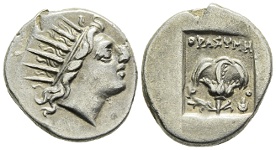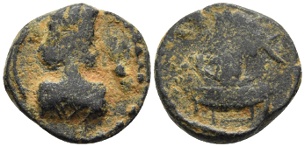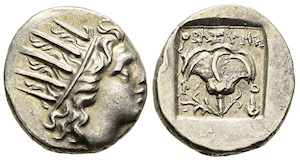Fine Coins Showcase
Antiquities Showcase
Hide empty categories
Shop Search
Shopping Cart
My FORVM
Contact Us
About Forum
Shopping at Forum
Our Guarantee
Payment Options
Shipping Options & Fees
Privacy & Security
Forum Staff
Selling Your Coins
Identifying Your Coin
FAQs
zoom.asp
Home ▸ Catalog ▸ |Featured Collections| ▸ |Michael Arslan Collection||View Options:   | | | | | | |


In Greek mythology, Talos (or Talon) was a giant winged man of bronze who protected Europa in Crete from pirates and invaders. He circled the island's shores three times daily. The author of Bibliotheke thought Talos' bronze nature might indicate he was a survivor from Hesiod's mythical Age of Bronze. The satirist Lucian took this absurd notion that men of Hesiod's Age of Bronze were actually made of bronze and, for humorous effect, extended it to men of the Age of Gold.GB95889. Bronze AE 18, Svoronos Crète 74; SNG Cop 520; BMC Crete p. 64, 27, VF, tight flan, encrustations, deposits, weight 5.271 g, maximum diameter 17.7 mm, die axis 180o, Phaistos (Faistos, Crete, Greece) mint, 300 - 250 B.C.; obverse Talos advancing right, nude, wings open, hurling stone in his right hand, holding another in his left hand; reverse hound on the scent to right, ΦAIC/TIΩN in two lines, starting above, ending in exergue; from the Michael Arslan Collection; very rare; SOLD
Islamic, Great Seljuk, Muhammad Alp Arslan, as Governor in Herat, 1058 - 1063 A.D.


Muhammad Alp Arslan's real name was Muhammad bin Dawud Chaghri, and for his military prowess, personal valor, and fighting skills he obtained the name Alp Arslan, which means "Heroic Lion" in Turkish.SH70939. Gold dinar, Album K1670, VF, typical areas of flat strike, weight 3.089 g, maximum diameter 23.8 mm, die axis 45o, Herat mint, AH 452, 1060 - 1061 A.D.; from the Michael Arslan Collection; ex CNG Auction 234, lot 593; very rare; SOLD
Hostilian, Summer - November 251 A.D., Antioch, Seleukis and Pieria, Syria


Hostilian was the younger son of Trajan Decius. After the latter's death, Hostilian was elevated to Augustus by his father's successor Trebonianus Gallus. He died of plague shortly after. McAlee notes, "Hostilian's Antiochene provincial coins are the rarest of the emperors of the 3rd century."RP95883. Billon tetradrachm, McAlee 1162 (very rare, same obverse die), Prieur 653 (2 spec.), Dura 574; BMC Galatia, p. 226, 627 var. (no officina indicated), VF, porosity, light deposits, weight 10.361 g, maximum diameter 25.2 mm, die axis 0o, 6th officina, Antioch (Antakya, Turkey) mint, as caesar, 250 - summer 251 A.D.; obverse Γ OVA OCTIΛ ME KVINTOC KECAP, bareheaded and draped bust right, from the front, VI below; reverse ΔHMAPX EΞOVCIAC (holder of Tribunitian power), eagle standing right on palm branch, head right, wings open, wreath in beak, S C (senatus consulto) in exergue; from the Michael Arslan Collection, only one specimen on Coin Archives; very rare; SOLD
Palmyra, Palmyrene, Syria, 2nd - 3rd Century A.D.


Palmyra, a city in a large oasis in the Syrian Desert, 215 km (134 miles) northeast of Damascus, was a vital silk road caravan stop, known as "the Bride of the Desert." The earliest documented reference to the city by its Semitic name Tadmor ("the indomitable town") is recorded in Babylonian tablets found in Mari.GY97505. Bronze AE 16, De Saulcy 2, Lindgren III A1141a, SNG Cop -, BMC Galatia -, VF, green patina, some bare metal high points, slightly off center, weight 3.649 g, maximum diameter 15.8 mm, die axis 0o, Palmyra mint, pseudo-autonomous, 2nd - 3rd centuries A.D.; obverse turreted head of Tyche right; reverse caduceus between two crossed cornucopia within wreath; from the Michael Arslan Collection; extremely rare; SOLD
Rhodos, Carian Islands, c. 88 - 84 B.C.


The Island of Rhodos was an important slave-trading center. It is perhaps best known for “The Colossus of Rhodos,” one of the Seven Wonders of the Ancient World, a giant statue of Helios that was a source of inspiration for the American Statue of Liberty.GS111909. Silver plinthophoric drachm, Jenkins Rhodian, group E, 243; HN Online 895; HGC 6 1461 (S); SNG Keckman -; SNG Cop -; SNG Mun -; BMC Caria -, gVF, minor edge flaw, die break before nose, weight 2.778 g, maximum diameter 15.4 mm, die axis 0o, Rhodos (Rhodes, Greece) mint, magistrate Thrasymedes, c. 88 - 84 B.C.; obverse radiate head of Helios right; reverse rose with tendrils below and bud lower left, ΘPAΣYMH above, P-O flanking across the field, Isis crown (control symbol) lower right, all within incuse square; from the Michael Arslan Collection; rare with this control symbol; SOLD
Palmyra, Palmyrene, Syria, c. 150 - 225 A.D.


Palmyra, a city in a large oasis in the Syrian Desert, 215 km northeast of Damascus, was the vital silk road caravan stop known as "the Bride of the Desert." Atargatis was the chief goddess of northern Syria, primarily a fertility goddess, but, she was also responsible for the protection and well-being of the people. Her chief sanctuary was at Hierapolis, modern Manbij, northeast of Aleppo, Syria. The Romans called her Dea Syria.GB95894. Bronze AE 12, SNG Munchen 519; BMC Galatia p. 149, 2; Krzyzanowska Monnayage IV; SNG Cop -, gF, dark patina, earthen deposits, weight 1.663 g, maximum diameter 12.0 mm, die axis 0o, Palmyra (Tadmur, Syria) mint, c. 150 - 225 A.D.; obverse Atargatis bust facing, head left, wearing turreted crown, thin crescent left, star right; reverse radiate bust of young Malakbel (solar deity) left; from the Michael Arslan Collection; extremely rare; SOLD
Nero, 13 October 54 - 9 June 68 A.D.


The reverse legend translates, "the Roman people are at peace everywhere, the Temple of Janus doors are closed." On the rare occasions when Rome was not at war the doors of the 'Twin Janus' were ceremonially closed, an event Nero commemorated extensively on the coinage of 65 - 67 A.D. -- Roman Coins and Their Values, Vol. 1 by David R. SearSL95899. Copper as, RIC I 350, BMCRE I 231, Cohen I 175, Hunter I 104 var. (head right), BnF II -, SRCV I -, NGC VF, strike 4/5, surface 2/5 (6155614-002), weight 10.557 g, maximum diameter 28.7 mm, die axis 180o, Rome mint, c. 66 A.D.; obverse IMP NERO CAESAR AVG GERM, laureate head left; reverse PACE P R VBIQ PARTA IANVM CLVSIT, view of the Temple of Janus from the front left corner, temple front on the right with garland over closed doors within arch, the left side of the temple to the left with long latticed window, S - C (senatus consulto) flanking across field; from the Michael Arslan Collection, NGC| Lookup; SOLD
Rhodos, Carian Islands, c. 88 - 84 B.C.


The Island of Rhodos was an important slave-trading center. It is perhaps best known for “The Colossus of Rhodos,” one of the Seven Wonders of the Ancient World, a giant statue of Helios that was a source of inspiration for the American Statue of Liberty.GS113179. Silver plinthophoric drachm, Jenkins Rhodian, group E, 243; HN Online 895; HGC 6 1461 (S); SNG Keckman -; SNG Cop -; SNG Mun -; BMC Caria -, aEF, obv. slightly off center, weight 2.275 g, maximum diameter 14.2 mm, die axis 0o, Rhodos (Rhodes, Greece) mint, magistrate Thrasymedes, c. 88 - 84 B.C.; obverse radiate head of Helios right; reverse rose with tendrils below and bud lower left, ΘPAΣYMH above, P-O flanking across the field, Isis crown (control symbol) lower right, all within incuse square; from the Michael Arslan Collection; rare with this control symbol; SOLD
Titus, 24 June 79 - 13 September 81 A.D., Judaea Capta


On 14 April 70 A.D. Titus surrounded Jerusalem. He allowed pilgrims to enter to celebrate Passover but this was a trap to put pressure on supplies of food and water; he refused to allow them to leave. On 10 May he began his assault on the walls. The third wall fell on 25 May. The second wall fell on 30 May. On 20 July Titus stormed the Temple Mount. On 4 August 70 A.D. Titus destroyed the Temple. The Jewish fast of Tisha B'Av mourns the Fall of Jerusalem annually on this date.RS99556. Silver denarius, Hendin 6614 (R); RIC II-1 30 (R2); BMCRE II 15; BnF III 12; RSC II 274; Hunter I 8; SRCV I -, F/aF, centered, very light toning, light marks, weight 3.019 g, maximum diameter 19.8 mm, die axis 180o, Rome mint, 1 Jul - end 79 A.D.; obverse IMP TITVS CAES VESPASIAN AVG P M, laureate head right; reverse TR P VIIII IMP XIIII COS VII P P, male Jewish captive kneeling right, at the base of a trophy of captured arms on his far side, his hands bound behind his back; from the Michael Arslan Collection; rare; SOLD
Tiberius, 19 August 14 - 16 March 37 A.D., Laodicea ad Lycum, Phrygia


BMC Phrygia and older references assign this type to Augustus. RPC I assigns it to Tiberius but notes the difficulty in determining if it is a coin of Augustus or Tiberius. It certainly looks like Augustus, but many portraits of Tiberius intentionally exaggerate his resemblance to Augustus.RP111927. Leaded bronze AE 20, RPC I 2901; SNG Cop 550; BMC Phrygia p. 301, 138; Weber 7137; AMC I 1402; Waddington 6264; SNG Lewis 1595, VF, dark patina, light earthen deposits, scratches (some flan adjustment marks), weight 4.773 g, maximum diameter 19.4 mm, die axis 315o, Laodicea ad Lycus (near Denizli, Turkey) mint, obverse ΣEBAΣTOΣ, bare head right; reverse Zeus Laodiceus standing facing, head left, eagle in extended right hand, staff in left hand, star over pileus flanking both left and right; ΛAOΔIKEΩN downward in left; ΠYΘHΣ / ΠYΘOY (Pythes, son of Pythes [magistrate]) in two downward lines on the right; from the Michael Arslan Collection; SOLD

You are viewing a SOLD items page.
Click here to return to the page with AVAILABLE items.
The sale price for a sold item is the private information of the buyer and will not be provided.



Page created in 1.109 seconds.






